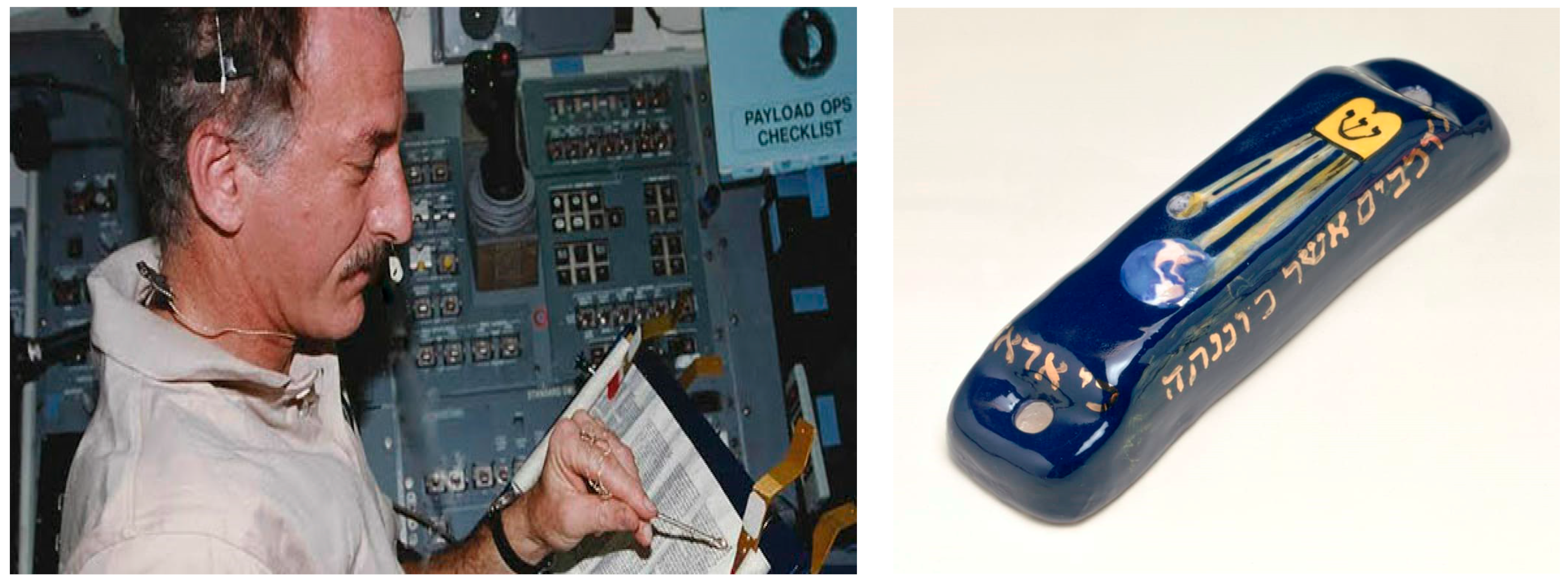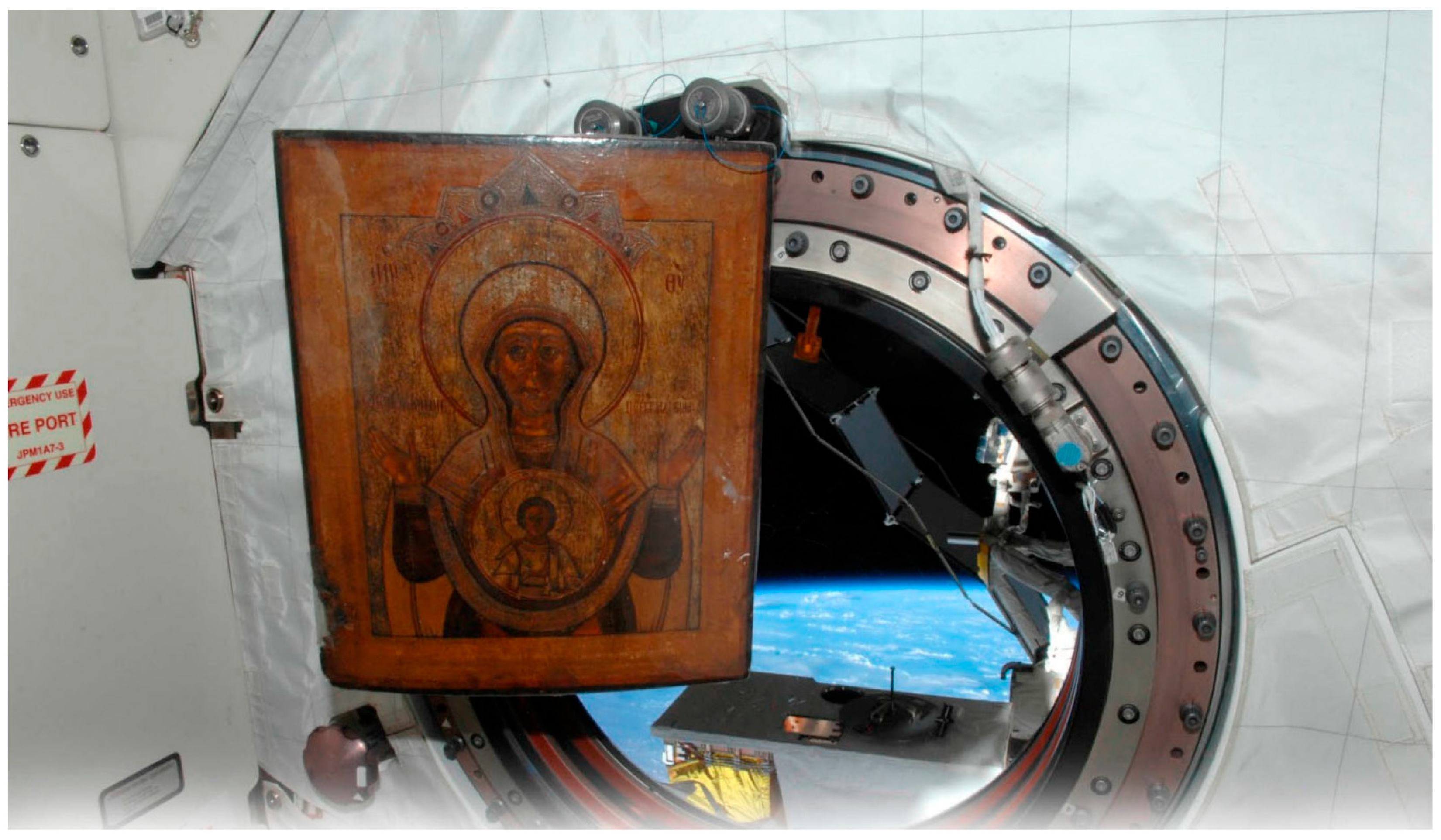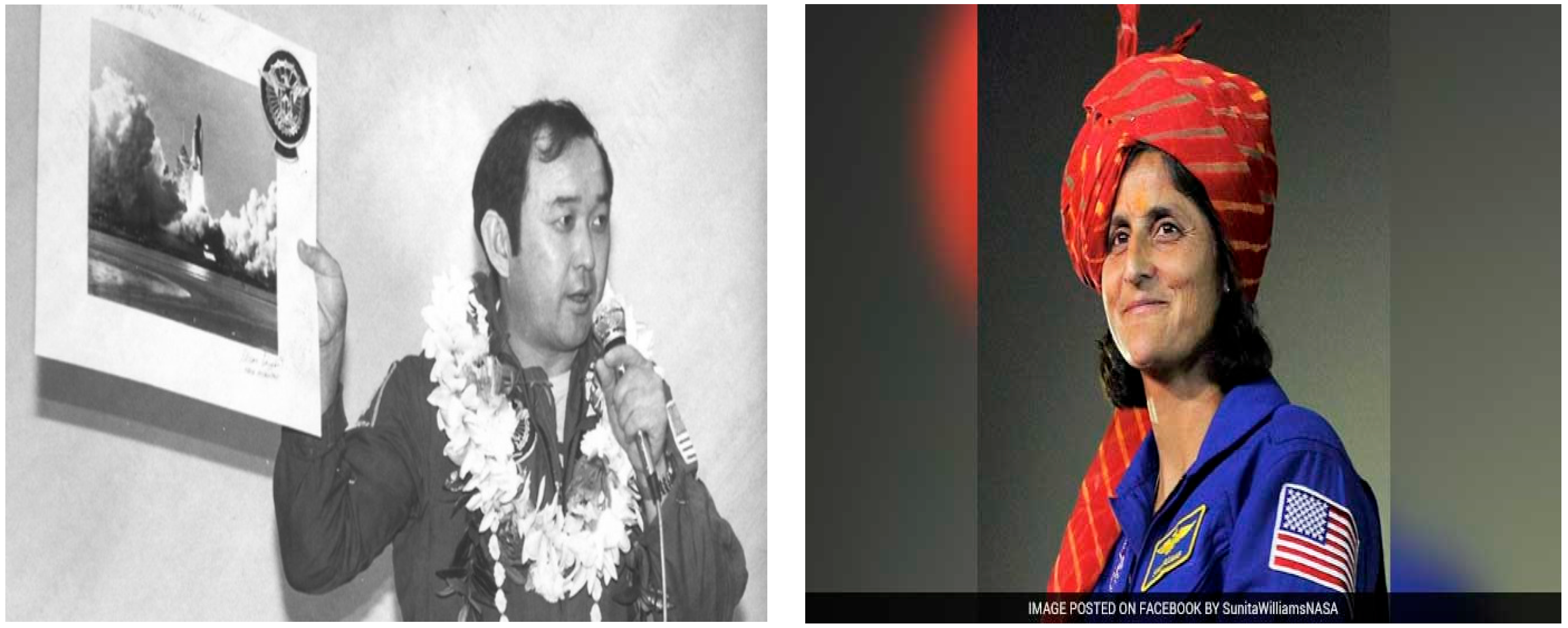Psycho-Religious Experiences in Deep Space History: Astronaut’s Latent Countermeasures for Human Risk Management
Abstract
1. Introduction
2. Interrelation of Science with Religion
3. Sacred Expression of Astronauts during Space Exploration
4. Psychological Security and Religious Attitude in Human Risk Management
4.1. American Christian Astronauts
4.2. Roman Catholic Astronauts
- Pope—
- ”when you are contemplating Earth from up there, do you ever wonder about the way nations and people live together down here, about how science can contribute to the cause of peace.”
- Kelly—
- ”… because the space station is run entirely on limitless solar power, better development of that technology could reduce the struggle over energy resources—A cause of much violence and war in the world” [50].
I thanked God each night before falling asleep for these glorious views of Earth and for the success of our mission thus far. I asked for the continued safety of our crew and a joyful reunion with our families. I was conscious of the special gift of each day in space, aware of the unique privilege I had been granted. And I remembered Father Tom Bevan’s words on the beach back in Florida [53].Jones, who experienced four Space Shuttle flights, shared his feeling that “Endeavour was rolled nearly upside down to aim its radars at Earth. What a privilege to work there for 12 h each day!…, I couldn’t help but marvel at the infinite power behind its creation” [52]. In this regard, Sky Walking: An Astronaut’s Memoir examined the interrelation between religion and mental health confidence, showing that the Catholic Jones maintained an optimistic outlook which was based on this faith [53] and that he took “solace in believing that his father and grandparents are going to relay his prayers directly to God” [54].

4.3. Jewish Astronauts
4.4. Russian Orthodox Cosmonauts
I, like all my cosmonaut friends, grew up in our socialist reality and studied in our Soviet schools. [but, now] I have a bible in my library, [and] this is why we discussed whether cosmonauts, in the course of their studies and training, should somehow be informed a little about this god and religion business.[64]
4.5. Asian and Islamic Astronauts
5. Conclusions
Funding
Data Availability Statement
Conflicts of Interest
References
- Grünschloß, A. Waiting for the ‘Big Beam’: UFO Religions and ‘Ufological Themes in New Religious Movements. In The Oxford Handbook of New Religious Movements; Lewis, J.R., Ed.; Oxford University Press: Oxford, UK, 2003; pp. 420–444. [Google Scholar] [CrossRef]
- Richter, J. Traces of the Gods: Ancient Astronauts as a Vision of Our Future. Numen 2012, 59, 222–227. [Google Scholar] [CrossRef]
- Bielo, J.S. Incorporation Space: Protestant Fundamentalism and Astronomical Authorization. Religions 2020, 11, 594. [Google Scholar] [CrossRef]
- Helmreich, R.L.; Wilhelm, J.A.; Runge, T.E. Psychological Considerations in Future Space Missions. In Human Factors of Outer Space Production; Cheston, S.T., Ed.; Routledge: London, UK; New York, NY, USA, 2019; pp. 1–15. [Google Scholar]
- Orloff, R.W.; Harland, D.M. Apollo: The Definitive Sourcebook; Springer Science + Business Media: Berlin/Heidelberg, Germany, 2006. [Google Scholar]
- Paustian, A.; Stibitz, S.; Worden, A. A Quarter Million Steps: Creativity, Imagination, & Leading Transformation Change; BookPress Publishing: West Des Moines, IA, USA, 2017. [Google Scholar]
- Zhan, H. The wide-field multiband imaging and slitless spectroscopy survey to be carried out by the Survey Space Telescope of China Manned Space Program. Ke Xue Tong Bao 2021, 66, 1290–1298. [Google Scholar] [CrossRef]
- Zhang, X.; Zhao, S.-H.; Wang, L.-T.; Xing, J.; Zhang, S.-F.; Liang, X.-L.; He, Z.; Wang, P.; Zhao, X.-J.; He, M.; et al. Simulation and measurement of millimeter-wave radiation from Josephson junction array. Chin. Phys. B 2019, 28, 060305. [Google Scholar] [CrossRef]
- Chai, S. How Catastrophic Innovation Failure Affects Organizational and Industry Legitimacy: The 2014 Virgin Galactic Test Flight Crash. Organ. Sci. 2022, 33, 1068–1093. [Google Scholar] [CrossRef]
- Cox, B.D.; Schmidt, L.L.; Slack, K.J.; Foster, T.C. Assessment and Selection of Military Aviators and Astronauts. In Aeromedical Psychology; Kennedy, C.H., Kay, G.G., Eds.; CRC Press: Boca Raton, FL, USA, 2017; pp. 30–36. [Google Scholar]
- Traphagan, J.W. Religion, Science, and Space Exploration from a Non-Western Perspective. Religions 2020, 11, 397. [Google Scholar] [CrossRef]
- Wilson, C.R. American Heavens: Apollo and the Civil Religion. J. Church State 1984, 26, 209–226. [Google Scholar] [CrossRef]
- Weibel, D.L.; Swanson, G.E. Introduction to Special Issue: The Mutual Influence of Religion and Space in the Human Understanding and Exploration of Outer Space. Religions 2021, 12, 444. [Google Scholar] [CrossRef]
- Balint, T.S.; Lee, C.H. Pillow talk—Curating delight for astronauts. Acta Astronaut. 2019, 159, 228–237. [Google Scholar] [CrossRef]
- Smith, K.C. Cosmogenesis, Complexity, and Neo-Natural Faith in the Context of Astrobiology. Religions 2020, 11, 659. [Google Scholar] [CrossRef]
- Ferrè, E.R. Mars Missions Could Leave Astronauts with Severe Psychological Damage—New Study. The Conversation, 20 March 2021. Available online: https://thenextweb.com/news/mars-missions-astronauts-psychological-damage-syndication?utm_content=user%2Fthenextweb&utm_source=flipboard (accessed on 1 January 2023).
- Comins, N. The Traveler’s Guide to Space: For One-Way Settlers and Round-Trip Tourists; Columbia University Press: New York, NY, USA, 2017; pp. 80–89. [Google Scholar]
- Gould, S.J. Rocks of Ages: Science and Religion in the Fullness of Life; Ballantine Books: New York, NY, USA, 2002. [Google Scholar]
- Roveda, J.M.; Fink, W.; Chen, K.; Wu, W.-T. Psychological Health Monitoring for Pilots and Astronauts by Tracking Sleep-Stress-Emotion Change. In Proceedings of the 2016 IEEE Aerospace Conference, Big Sky, MT, USA, 5–12 March 2016. [Google Scholar] [CrossRef]
- Rozanov, I.A.; Karpova, O.; Shved, D.; Savinkina, A.; Kuznetsova, P.; Rey, N.D.; Shishenina, K.; Gushin, V. Applications of methods of psychological support developed for astronauts for use in medical settings. Front. Physiol. 2022, 13, 926597. [Google Scholar] [CrossRef] [PubMed]
- Liu, X. The Psychological Experience of Astronauts and How It Can Be Depicted in Artworks. Master’s Thesis, Syracuse University, Syracuse, NY, USA, May 2022. [Google Scholar]
- Feed, W. Psychological Problems Astronauts May Experience. 2021. Available online: https://www.proquest.com/docview/2516724423?pq-origsite=primo&parentSessionId=ayEGKRq%2BgqgXY%2B2KZ0oZw%2BJdPzrdC7kQakFtPoGdIhc%3D (accessed on 12 April 2023).
- Haupt, G.F. Astronautics and psychology: Recommendations for the psychological training of astronauts. Acta Astronaut. 1991, 25, 733–736. [Google Scholar] [CrossRef] [PubMed]
- Leon, G.R.; Sandal, G.M.; Fink, B.A.; Ciofani, P. Positive experiences and personal growth in a two-man North Pole expedition team. Environ. Behav. 2011, 43, 710–731. [Google Scholar] [CrossRef]
- Ambrosius, J.D. Separation of church and space: Religious influences on public support for U.S. space exploration policy. Space Policy 2015, 32, 17–31. [Google Scholar] [CrossRef]
- Weibel, D.L. Space Exploration as Religious Experience: Evangelical Astronauts and the Perception of God’s Worldview. The Space Review. Available online: https://www.thespacereview.com/article/3310/1 (accessed on 4 January 2023).
- Ambrosius, J.D. Reexamining the ‘Separation of Church and Space’: Evangelical Protestant Support for Space Exploration in the Trump-Pence Age. Religions 2020, 11, 590. [Google Scholar] [CrossRef]
- Oliver, K. The Apollo 8 Genesis Reading and Religion in the Space Age. Astropolitics Int. J. Space Policy 2013, 11, 116–117. [Google Scholar] [CrossRef]
- Ayoub, N.C. Closer to God: Religion and the American Space Program. The Chronicle of Higher Education, Washington, 25 February 2013. [Google Scholar]
- Coben, J.D. Viewpoints: Spaceflight and the Separation of Church and State. Astropolitics Int. J. Space Policy 2013, 11, 105–107. [Google Scholar]
- Hansen, J.R. A Reluctant Icon: Letters to Neil Armstrong; Purdue University Press: West Lafayette, IN, USA, 2020; p. 1. [Google Scholar]
- Weibel, D.L. Following the Path That Heroes Carved into History: Space Tourism, Heritage, and Faith in the Future. Religions 2020, 11, 23. [Google Scholar] [CrossRef]
- Williams, J.N. The Work of His Hands: A View of God’s Creation from Space; Concordia Publishing House: St Louis, MI, USA, 2010; p. 153. [Google Scholar]
- Ihle, E.C.; Ritsher, J.B.; Kanas, N. Positive psychological outcomes of space flight: An empirical study. Aviat. Space Environ. Med. 2006, 77, 93–101. [Google Scholar]
- Volz, B. A day in space: Here’s What an Astronaut’s Daily Routine Looks Like: Even Astronauts’ Free Time Is Scheduled. Space News, 20 November 2020. Available online: https://www.clickorlando.com/news/space-news/2020/11/14/a-day-in-space-heres-what-an-astronauts-daily-routine-looks-like/ (accessed on 18 January 2023).
- Mittelmark, M.B.; Bauer, G.F.; Vaandrager, L.; Pelikan, J.M.; Sagy, S.; Eriksson, M.; Lindström, B.; Magistretti, C.M. The Handbook of Salutogenesis, 2nd ed.; Springer Nature: London, UK; New York, NY, USA; Berlin, Germany, 2022. [Google Scholar]
- Ventegodt, S.; Thegler, S.; Andreasen, T.; Struve, F.; Enevoldsen, L.; Bassaine, L.; Torp, M.; Merrick, J. Clinical Holistic Medicine (Mindful, Short-Term Psychodynamic Psychotherapy Complemented with Bodywork) Improves Quality of Life, Health, and Ability by Induction of Antonovsky-Salutogenesis. Sci. World J. 2007, 7, 317–323. [Google Scholar] [CrossRef]
- Ritsher, J.B.; Ihle, E.C.; Kanas, N. Positive psychological effects of space missions. Acta Astronaut. 2005, 57, 630–633. [Google Scholar] [CrossRef]
- Suedfeld, P. Space Memoir: Value Hierarchies before and after Mission—A Pilot Study. Acta Astronaut. 2006, 58, 583–586. [Google Scholar] [CrossRef]
- Spinney, R. To Touch the Face of God: The Sacred, the Profane, and American Space Program, 1957–1975; Oliver, K., Ed.; Johns Hopkins University Press: Baltimore, MD, USA, 2012; pp. xiii + 229. [Google Scholar]
- Mersch, C. Religion, Space Exploration, and Secular Society. Astropolitics Int. J. Space Policy 2013, 11, 67. [Google Scholar] [CrossRef]
- Millard, E. The Only Bible on the Moon Was Left There by an Episcopalian on Behalf of His Parish. Episcopal News Service, 19 July 2019. Available online: https://www.episcopalnewsservice.org/2019/07/19/the-only-bible-on-the-moon-was-brought-there-by-an-episcopalian-on-behalf-of-his-parish/ (accessed on 6 January 2023).
- Marazziti, D.; Arone, A.; Ivaldi, T.; Kuts, K.; Loganovsky, K. Space missions: Psychological and psychopathological issues. CNS Spectr. 2022, 27, 536–540. [Google Scholar] [CrossRef] [PubMed]
- Elliott, R.W. Aviation Mental Health and the Psychological Examination. In Aeromedical Psychology; Kennedy, C.H., Kay, G.G., Eds.; CRC Press: Boca Raton, FL, USA, 2017; pp. 76–90. [Google Scholar]
- Noble, D.F. The Religion of Technology: The Divinity of Man and the Spirit of Invention; Penguin Books: London, UK, 1997; pp. 184–187. [Google Scholar]
- Anonymous. Tragedy and Testimony. New Am. Appleton 2003, 19, 8. [Google Scholar]
- Cho, D.Y. The Module of Faith. In Best 10 Mines Sermon Series. Available online: https://m.youtube.com/watch?v=dBnl6IJaikU&feature=youtu.be (accessed on 27 January 2023).
- Consolmagno, G. Space and the Papacy. Religions 2020, 11, 654. [Google Scholar] [CrossRef]
- Arnould, J. Space and Human Culture; ATF Press: Adelaide, Australia, 2016; pp. 25–35. [Google Scholar]
- Auza, B. Statement on Agenda Item 53: Cooperation in The Peaceful Uses of Outer Space. In Proceedings of the Fourth Committee of the 70th Session of the General Assembly, New York, NY, USA, 19 October 2015. [Google Scholar]
- Kim, D.W. Mars Space Exploration and Astronautical Religion in Human Research: Psychological Countermeasures of Long-term Astronauts. Aerospace 2022, 9, 814. [Google Scholar] [CrossRef]
- Jones, T.D. Reading the Heavens: An Astronaut’s Spiritual Journey. St. Anthony Messenger 2004, 112, 30–34. [Google Scholar]
- Jones, T. Sky Walking: An Astronaut’s Memoir; HarperCollins: New York, NY, USA, 2007. [Google Scholar]
- Murphy, P.J. (Review) Sky Walking: An Astronaut’s Memoir by Tom Jones. St. Anthony Messenger 2006, 114, 60. [Google Scholar]
- Cooperman, J. To see the Earth Go By. Natl. Cathol. Rep. 2009, 45, 17. [Google Scholar]
- Harrison, D.H. ‘Jews in Space’ Lecture Filled with Anecdotes. San Diego Jewish World, 11 April 2021. Available online: https://www.sdjewishworld.com/2021/04/11/jews-in-space-lecture-filled-with-anecdotes/ (accessed on 17 January 2023).
- Belt, A. Jewish Astronauts Hall of Fame Takes Flight. Baltimore Jewish Times, 2 February 2018; p. 15. Available online: https://www.jewishtimes.com/jewish-astronauts-hall-of-fame-takes-flight/ (accessed on 3 November 2022).
- Joseph, D. Hello, Mishnah Control? Reflections on the First Aliyah in Space by a NASA Frequent Flyer. Jewish Exponent [Philadelphia], 7 August 1997; p. 9. Available online: https://www.proquest.com/docview/227244150?pq-origsite=primo (accessed on 17 January 2023).
- Solomon, L.K. The First Jewish Astronaut. Baltim. Jew. Times 1994, 220, 50. [Google Scholar]
- Petre, J. Jewish Astronaut Asks When to Mark the Sabbath. National Post, 27 May 2002. Available online: https://www.proquest.com/docview/329864392?pq-origsite=primo (accessed on 17 January 2023).
- Wahrman, M.Z. Light Years Away: For Jewish Astronaut, a Great Miracle happened on ‘Mir’. Jewish Exponent [Philadelphia], 25 December 1997; p. 8. Available online: https://www.proquest.com/docview/227229271?parentSessionId=sU5%2Bo1LsfyWWfknQyAA13mI15Ul0AJcsB0SrNzNnN5M%3D&pq-origsite=primo&accountid=8330 (accessed on 17 January 2023).
- Bigus, R.B. Reaching for the Stars: Two Jewish astronauts will be aboard the space shuttle Columbia when it takes off next week. Baltim. Jew. Times 1993, 213, 44. [Google Scholar]
- Smolkin, V. A Sacred Space Is Never Empty: A History of Soviet Atheism; Princeton University Press: Princeton, NJ, USA, 2018; pp. 84–86. [Google Scholar]
- Maurer, E.; Richers, J.; Rüthers, M.; Scheide, C. Soviet Space Culture: Cosmic Enthusiasm in Socialist Societies; Palgrave Macmillan: London, UK, 2011. [Google Scholar]
- Gorman, A.; Walsh, J. How to live in space: What we’ve learned from 20 years of the International Space Station. The Conversation, 2 November 2020; pp. 1–6. Available online: https://theconversation.com/how-to-live-in-space-what-weve-learned-from-20-years-of-the-international-space-station-144851 (accessed on 17 January 2023).
- Suedfeld, P.; Brcic, J.; Johnson, P.J.; Gushin, V. Personal growth following long-duration spaceflight. Acta Astronaut. 2012, 79, 118–123. [Google Scholar] [CrossRef]
- Anonymous. Home from home: We cannot look to the stars to solve our planet’s problems. Nature 2016, 539, 330. [Google Scholar]
- Dart, J. Astronaut Remembered as First Buddhist in Space. Los Angeles Times, 1 February 1986; p. 5. Available online: https://www.latimes.com/archives/la-xpm-1986-02-01-me-3021-story.html (accessed on 23 January 2023).
- Chang, T.; Kwan, K.-L.K. Asian American Racial and Ethnic Identity in Nita Tewari and the ‘Apollo Mezuza’. The Jerusalem Post, 2 June 2008. Available online: https://www.jpost.com/jewish-world/jewish-news/the-apollo-mezuza (accessed on 17 January 2023).
- McGowan, J. Impossible Journey: India’s First Astronaut. Commonweal 2003, 130, 8. [Google Scholar]
- ABC News. Columbia Crew Was of 7 Different Faiths. 2003. Available online: https://abcnews.go.com/Technology/story?id=97741&page=1 (accessed on 16 February 2023).
- Sloat, S. The Key to Survival on Mars Is Religion, Argues Scientist. Available online: https://www.inverse.com/article/38069-mars-colonies-space-religion-konrad-szocik (accessed on 11 June 2021).
- Lewis, C.S. Muslims in Space: Observing Religious Rites in a New Environment. Astropolitics 2013, 11, 108–115. [Google Scholar] [CrossRef]
- Goemaere, S.; Van Caelenberg, T.; Beyers, W.; Binsted, K.; Vansteenkiste, M. Life on mars from a Self-Determination Theory perspective: How astronauts’ needs for autonomy, competence and relatedness go hand in hand with crew health and mission success—Results from HI-SEAS IV. Acta Astronaut. 2019, 159, 273–285. [Google Scholar] [CrossRef]
- Brean, J. Islam’s Space Odyssey. National Post, 15 October 2007. Available online: https://www.proquest.com/docview/330705099?parentSessionId=jgWnPsRh52pv6UAnvrvMvJ6NgYbQHuHTFwZjt%2BkOe1o%3D&pq-origsite=primo&accountid=8330 (accessed on 23 January 2023).
- Mars, K. Active NASA Astronauts. National Aeronautics and Space Administration (NASA). Available online: https://www.nasa.gov/astronauts/biographies/active (accessed on 21 January 2023).
- Sieber, J.E. Well-being and Privacy in Space: Anticipating Conflicts of Interests. In Human Factors of Outer Space Production; Cheston, S.T., Ed.; Routledge: London, UK; New York, NY, USA, 2019; pp. 65–78. [Google Scholar]
- Makay, C.D.; Standage, M. Astronaut Adherence to exercise-based reconditioning: Psychological considerations and future directions. Musculoskelet. Sci. Pract. 2017, 27 (Suppl. S1), S38–S41. [Google Scholar] [CrossRef]
- Ciocca, G.; Tschan, H. The Enjoyability of Physical Exercise: Exergames and Virtual Reality as New Ways to Boost Psychological and Psychosocial Health in Astronauts. A Prospective and Perspective View. IEEE Open J. Eng. Med. Biol. 2023, 99, 1–8. [Google Scholar] [CrossRef]
- Zook, D.C. Making Space for Islam: Religion, Science, and Politics in Contemporary Malaysia. J. Asian Stud. 2010, 69, 1156–1162. [Google Scholar] [CrossRef]
- Siddique, H. UK’s First Muslim Astronaut Aims to Put Focus on Mental Health. The Guardian, 26 December 2016; p. 14. Available online: https://www.theguardian.com/society/2016/dec/26/uks-first-muslim-astronaut-aims-to-put-focus-on-mental-health (accessed on 23 January 2023).
- Dialogue of His Holiness Pope Francis with the Crew of the International Space Station. NBC News, 27 October 2017. Available online: https://www.nbcnews.com/news/pope-francis/pope-francis-dials-heavens-gets-philosophical-astronauts-aboard-space-station-n814571 (accessed on 27 January 2023).
- 50 Years of Jews in Space: David Wolf. Jewish Independence, 12 July 2019. Available online: https://www.jewishindependent.ca/tag/david-wolf/ (accessed on 17 January 2023).
- The ‘Apollo Mezuza’. The Jerusalem Post, 2 June 2008. Available online: https://www.jpost.com/jewish-world/jewish-news/the-apollo-mezuza (accessed on 4 December 2022).
- In Northern India, Sikhs and Hindus Share Many Customs. ABC News, 4 February 2003. Available online: https://abcnews.go.com/Technology/story?id=97741&page=1 (accessed on 2 February 2023).
- Hines-Brigger, S. Pope Talks with Astronauts. St. Anthony Messenger 2011, 119, 10. [Google Scholar]
- Salmond, W.; Walsh, J.; Gorman, A. Eternity in Low Earth Orbit: Icons on the International Space Station. Religions 2020, 11, 611. [Google Scholar] [CrossRef]
- Cheston, S.T. Human Factors of Outer Space Production; Routledge: London, UK; New York, NY, USA, 2019. [Google Scholar]
- Pope Discusses Life’s Biggest Questions with International Space Station Crew. The Guardian, 27 October 2017. Available online: https://www.theguardian.com/world/2017/oct/26/pope-francis-to-call-international-space-station (accessed on 23 January 2023).
- Schiffer, K. When Astronauts Received Holy Communion in Space. National Catholic Register. Available online: https://www.ncregister.com/blog/when-astronauts-received-holy-communion-in-space (accessed on 17 January 2023).
- Levinson, P. The Missing Orientation. Religions 2021, 12, 16. [Google Scholar] [CrossRef]
- Oster, M. Astronaut Jessica Meir Offers Advice on Isolation from Space. Jewish Telegraphy Agency, 5 April 2020; 6. Available online: https://www.jta.org/quick-reads/astronaut-jessica-meir-offers-advice-on-isolation-from-the-international-space-station (accessed on 18 January 2023).




Disclaimer/Publisher’s Note: The statements, opinions and data contained in all publications are solely those of the individual author(s) and contributor(s) and not of MDPI and/or the editor(s). MDPI and/or the editor(s) disclaim responsibility for any injury to people or property resulting from any ideas, methods, instructions or products referred to in the content. |
© 2023 by the author. Licensee MDPI, Basel, Switzerland. This article is an open access article distributed under the terms and conditions of the Creative Commons Attribution (CC BY) license (https://creativecommons.org/licenses/by/4.0/).
Share and Cite
Kim, D.W. Psycho-Religious Experiences in Deep Space History: Astronaut’s Latent Countermeasures for Human Risk Management. Aerospace 2023, 10, 626. https://doi.org/10.3390/aerospace10070626
Kim DW. Psycho-Religious Experiences in Deep Space History: Astronaut’s Latent Countermeasures for Human Risk Management. Aerospace. 2023; 10(7):626. https://doi.org/10.3390/aerospace10070626
Chicago/Turabian StyleKim, David W. 2023. "Psycho-Religious Experiences in Deep Space History: Astronaut’s Latent Countermeasures for Human Risk Management" Aerospace 10, no. 7: 626. https://doi.org/10.3390/aerospace10070626
APA StyleKim, D. W. (2023). Psycho-Religious Experiences in Deep Space History: Astronaut’s Latent Countermeasures for Human Risk Management. Aerospace, 10(7), 626. https://doi.org/10.3390/aerospace10070626





